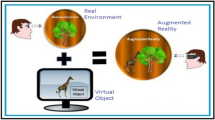Abstract
Many novel applications take on the task of moving the personal computer away from the desktop with the approach to merge digital information with physical space and objects. These new applications have given rise to a plethora of notions and terms used to classify them. We introduce amplified reality as a concept complementary to that of augmented reality. To amplify reality is to enhance the publicly available properties of persons and physical objects, by means of using wearable or embedded computational resources. The differences between the two concepts are discussed and examples of implementations are given. The reason for introducing this term is to contribute to the terminology available to discuss already existing applications, but also to open up for a discussion of interesting design implications.
Access this chapter
Tax calculation will be finalised at checkout
Purchases are for personal use only
Preview
Unable to display preview. Download preview PDF.
Similar content being viewed by others
References
Azuma, R. (1997). A Survey of Augmented Reality. In Presence: Teleoperators and Virtual Environments, pp. 355–385, MIT Press.
Bass, L., Kasabach, C., Martin, R. et al. (1997). The Design of a Wearable Computer. In Proceedings of CHI’97, ACM Press.
Demers, A. J. (1994). Research Issues in Ubiquitous Computing. In Proceedings of PODC’94, ACM Press.
Falk, J., and Björk, S. (1997) The BubbleBadge: A Public Wearable Display. In Extended Abstracts of CHI’99, ACM Press.
Feiner, S., MacIntyre, B., and Seligman, D. (1993). Knowledge-based Augmented Reality. In Communications of the ACM, Vol. 36, No. 7, ACM Press.
Holmquist, L.E., Falk, J., and Wigström, J. (1999) Supporting Group Collaboration with Inter-Personal Awareness Devices. To appear in Personal Technologies, Springer-Verlag.
Iwatani, Y. (1998). Love: Japanese Style. In Wired News, 11June, 1998.
Mann, S. (1997). Smart Clothing: The Wearable Computer and WearCam. Personal Technologies, Vol. 1, No. 1, Springer-Verlag.
Mynatt, E., Back, M., Want, R., et al. (1998). Designing Audio Aura. In Proceedings of CHI’98, ACM Press.
Rekimoto, J., Ayatsuka, Y., and Hayashi, K. (1998). Augment-able Reality: Situated Communication through Physical and Digital Spaces. In Proceedings of ISWC’98.
Starner, T., Mann, S., Rhodes, B., Levine, J., et al. (1997). Augmented Reality Through Wearable Computing. In Presence, Special Issue on Augmented Reality, MIT Press.
Streitz, N. A., and Russel, D. M. (1998). Basics of Integrated Information and Physical Spaces:The State of the Art.InExtended Abstracts of CHI’98, ACM Press.
Ullmer, B., and Ishii, H. (1997). The metaDESK: Models and Prototypes for Tangible User Interfaces. In Proceedings of UIST’97, ACM Press.
Weiser, M. (1991). The Computer for the Twenty-First Century. Scientific American, pp. 94–104.
Wisneski, C., Orbanes, J., and Ishii, H. (1998). PingPongPlus: Augmentation and Transformation of Athletic Interpersonal Interaction. In Extended Abstracts of CHI’98, ACM Press.
Author information
Authors and Affiliations
Editor information
Editors and Affiliations
Rights and permissions
Copyright information
© 1999 Springer-Verlag Berlin Heidelberg
About this paper
Cite this paper
Falk, J., Redström, J., Björk, S. (1999). Amplifying Reality. In: Gellersen, HW. (eds) Handheld and Ubiquitous Computing. HUC 1999. Lecture Notes in Computer Science, vol 1707. Springer, Berlin, Heidelberg. https://doi.org/10.1007/3-540-48157-5_25
Download citation
DOI: https://doi.org/10.1007/3-540-48157-5_25
Published:
Publisher Name: Springer, Berlin, Heidelberg
Print ISBN: 978-3-540-66550-2
Online ISBN: 978-3-540-48157-7
eBook Packages: Springer Book Archive




